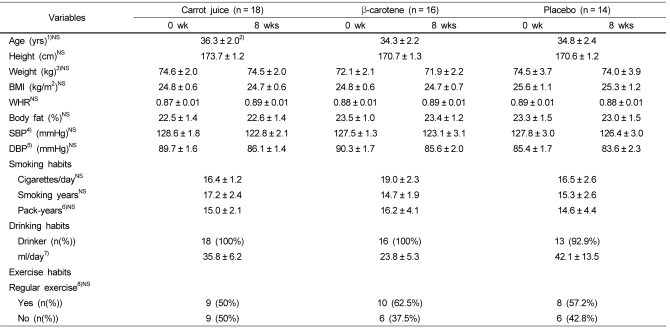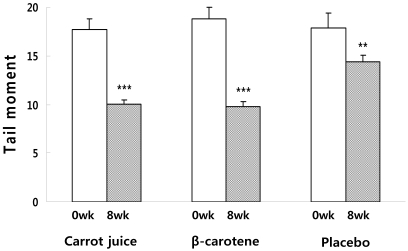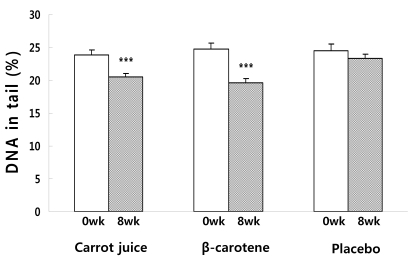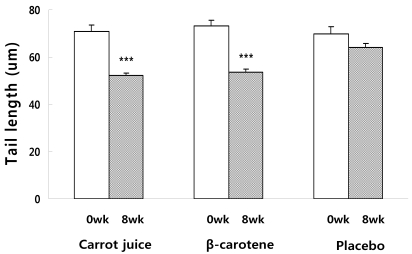1. Ames BN, Shigenaga MK, Hagen TM. Oxidants, antioxidants, and the degenerative diseases of aging. Proc Natl Acad Sci U S A. 1993; 90:7915–7922. PMID:
8367443.

2. Pryor WA, Stone K. Oxidants in cigarette smoke. Radicals, hydrogen peroxide, peroxynitrate, and peroxynitrite. Ann N Y Acad Sci. 1993; 686:12–27. PMID:
8512242.

3. Riso P, Martini D, Visioli F, Martinetti A, Porrini M. Effect of broccoli intake on markers related to oxidative stress and cancer risk in healthy smokers and nonsmokers. Nutr Cancer. 2009; 61:232–237. PMID:
19235039.

4. Wang MY, Lutfiyya MN, Weidenbacher-Hoper V, Anderson G, Su CX, West BJ. Antioxidant activity of noni juice in heavy smokers. Chem Cent J. 2009; 3:13. PMID:
19807926.

5. Riso P, Martini D, Møller P, Loft S, Bonacina G, Moro M, Porrini M. DNA damage and repair activity after broccoli intake in young healthy smokers. Mutagenesis. 2010; 25:595–602. PMID:
20713433.

6. van den Berg R, van Vliet T, Broekmans WM, Cnubben NH, Vaes WH, Roza L, Haenen GR, Bast A, van den Berg H. A vegetable/fruit concentrate with high antioxidant capacity has no effect on biomarkers of antioxidant status in male smokers. J Nutr. 2001; 131:1714–1722. PMID:
11385058.

7. Jacobson JS, Begg MD, Wang LW, Wang Q, Agarwal M, Norkus E, Singh VN, Young TL, Yang D, Santella RM. Effects of a 6-month vitamin intervention on DNA damage in heavy smokers. Cancer Epidemiol Biomarkers Prev. 2000; 9:1303–1311. PMID:
11142415.
8. Lee BM, Lee SK, Kim HS. Inhibition of oxidative DNA damage, 8-OHdG, and carbonyl contents in smokers treated with antioxidants (vitamin E, vitamin C, β-carotene and red ginseng). Cancer Lett. 1998; 132:219–227. PMID:
10397477.

9. Møller P, Viscovich M, Lykkesfeldt J, Loft S, Jensen A, Poulsen HE. Vitamin C supplementation decreases oxidative DNA damage in mononuclear blood cells of smokers. Eur J Nutr. 2004; 43:267–274. PMID:
15309445.

10. Albanes D, Heinonen OP, Taylor PR, Virtamo J, Edwards BK, Rautalahti M, Hartman AM, Palmgren J, Freedman LS, Haapakoski J, Barrett MJ, Pietinen P, Malila N, Tala E, Liippo K, Salomaa ER, Tangrea JA, Teppo L, Askin FB, Taskinen E, Erozan Y, Greenwald P, Huttunen JK. α-Tocopherol and β-carotene supplements and lung cancer incidence in the α-tocopherol, β-carotene cancer prevention study: effects of base-line characteristics and study compliance. J Natl Cancer Inst. 1996; 88:1560–1570. PMID:
8901854.
12. Kim JS, Yoon S. Isoflavone contents and β-glucosidase activities of soybeans, Meju, and Doenjang. Korean J Food Sci Technol. 1999; 31:1405–1409.
13. Hertog MGL, Hollman PCH, Katan MB. Content of potentially anticarcinogenic flavonoids of 28 vegetables and 9 fruits commonly consumed in the Netherlands. J Agric Food Chem. 1992; 40:2379–2383.

14. Hertog MG, Feskens EJ, Hollman PC, Katan MB, Kromhout D. Dietary antioxidant flavonoids and risk of coronary heart disease: the Zutphen Elderly Study. Lancet. 1993; 342:1007–1011. PMID:
8105262.

15. Hertog MG, Kromhout D, Aravanis C, Blackburn H, Buzina R, Fidanza F, Giampaoli S, Jansen A, Menotti A, Nedeljkovic S, Pekkarinen M, Simic BS, Toshima H, Feskens EJ, Hollman PC, Katan MB. Flavonoid intake and long-term risk of coronary heart disease and cancer in the seven countries study. Arch Intern Med. 1995; 155:381–386. PMID:
7848021.
16. Bilyk A, Cooper PL, Sapers GM. Varietal differences in distribution of quercetin and kaempferol in onion (Allium cepa L.) tissue. J Agric Food Chem. 1984; 32:274–276.

17. Bilyk A, Sapers GM. Distribution of quercetin and kaempferol in lettuce, kale, chive, garlic chive, leek, horseradish, red radish, and red cabbage tissues. J Agric Food Chem. 1985; 33:226–228.

18. Park YK, Kim Y, Park E, Kim JS, Kang MH. Estimated flavonoids intake in Korean adults using semiquantitative foodfrequency questionnaire. Korean J Nutr. 2002; 35:1081–1088.
19. Kim M, Kim MC, Park JS, Park EJ, Lee JO. Determination of antioxidants contents in various plants used as tea materials. Korean J Food Sci Technol. 1999; 31:273–279.
20. Rojas E, Lopez MC, Valverde M. Single cell gel electrophoresis assay: methodology and applications. J Chromatogr B Biomed Sci Appl. 1999; 722:225–254. PMID:
10068143.

21. Aebi H. Bergmeyer HU, editor. Catalase. Methods of Enzymatic Analysis. 1974. Weinheim: Verlag Chemie;p. 673–678.

22. Beutler E. Glutathione peroxidase. Red Cell Metabolism: A Manual of Biochemical Methods. 1984. Orlando: Grune and Stratton;p. 71–73.
23. Marklund S, Marklund G. Involvement of the superoxide anion radical in the autoxidation of pyrogallol and a convenient assay for superoxide dismutase. Eur J Biochem. 1974; 47:469–474. PMID:
4215654.

24. Friedewald WT, Levy RI, Fredrickson DS. Estimation of the concentration of low-density lipoprotein cholesterol in plasma, without use of the preparative ultracentrifuge. Clin Chem. 1972; 18:499–502. PMID:
4337382.

25. Hemilä H, Kaprio J. Modification of the effect of vitamin E supplementation on the mortality of male smokers by age and dietary vitamin C. Am J Epidemiol. 2009; 169:946–953. PMID:
19218294.
26. Li N, Jia X, Chen CY, Blumberg JB, Song Y, Zhang W, Zhang X, Ma G, Chen J. Almond consumption reduces oxidative DNA damage and lipid peroxidation in male smokers. J Nutr. 2007; 137:2717–2722. PMID:
18029489.

27. Lee J, Lee E, Oh E, Lee J, Sul D, Kim J. Increased DNA damage of lymphocytes in Korean male smokers. J Prev Med Public Health. 2007; 40:16–22. PMID:
17310594.

28. Yildiz A, Gür M, Yilmaz R, Demirbağ R, Celik H, Aslan M, Koçyiğit A. Lymphocyte DNA damage and total antioxidant status in patients with white-coat hypertension and sustained hypertension. Turk Kardiyol Dern Ars. 2008; 36:231–238. PMID:
18765966.
29. Zeyrek D, Cakmak A, Atas A, Kocyigit A, Erel O. DNA damage in children with asthma bronchiale and its association with oxidative and antioxidative measurements. Pediatr Allergy Immunol. 2009; 20:370–376. PMID:
18801009.

30. Gill CI, Haldar S, Boyd LA, Bennett R, Whiteford J, Butler M, Pearson JR, Bradbury I, Rowland IR. Watercress supplementation in diet reduces lymphocyte DNA damage and alters blood antioxidant status in healthy adults. Am J Clin Nutr. 2007; 85:504–510. PMID:
17284750.

31. Park YK, Lee SH, Park E, Kim JS, Kang MH. Changes in antioxidant status, blood pressure, and lymphocyte DNA damage from grape juice supplementation. Ann N Y Acad Sci. 2009; 1171:385–390. PMID:
19723080.

32. Schneider M, Diemer K, Engelhart K, Zankl H, Trommer WE, Biesalski HK. Protective effects of vitamins C and E on the number of micronuclei in lymphocytes in smokers and their role in ascorbate free radical formation in plasma. Free Radic Res. 2001; 34:209–219. PMID:
11264897.

33. Stracke BA, Rüfer CE, Bub A, Briviba K, Seifert S, Kunz C, Watzl B. Bioavailability and nutritional effects of carotenoids from organically and conventionally produced carrots in healthy men. Br J Nutr. 2009; 101:1664–1672. PMID:
19021920.

34. Pool-Zobel BL, Bub A, Müller H, Wollowski I, Rechkemmer G. Consumption of vegetables reduces genetic damage in humans: first results of a human intervention trial with carotenoid-rich foods. Carcinogenesis. 1997; 18:1847–1850. PMID:
9328185.

35. Kim HY, Lim YI, Russell RM. Changes in carotenoids contents in pureed and cooked carrot and spinach during storage. Korean J Soc Food Cookery Sci. 2003; 19:83–95.
36. Fernández-Pachón MS, Berná G, Otaolaurruchi E, Troncoso AM, Martín F, García-Parrilla MC. Changes in antioxidant endogenous enzymes (activity and gene expression levels) after repeated red wine intake. J Agric Food Chem. 2009; 57:6578–6583. PMID:
19722566.

37. Nielsen SE, Young JF, Daneshvar B, Lauridsen ST, Knuthsen P, Sandström B, Dragsted LO. Effect of parsley (Petroselinum crispum) intake on urinary apigenin excretion, blood antioxidant enzymes and biomarkers for oxidative stress in human subjects. Br J Nutr. 1999; 81:447–455. PMID:
10615220.

38. Freese R, Dragsted LO, Loft S, Mutanen M. No effect on oxidative stress biomarkers by modified intakes of polyunsaturated fatty acids or vegetables and fruit. Eur J Clin Nutr. 2008; 62:1151–1153. PMID:
17671440.
39. Park YK, Park E, Kim JS, Kang MH. Daily grape juice consumption reduces oxidative DNA damage and plasma free radical levels in healthy Koreans. Mutat Res. 2003; 529:77–86. PMID:
12943921.

40. Hall WL, Vafeiadou K, Hallund J, Bugel S, Reimann M, Koebnick C, Zunft HJ, Ferrari M, Branca F, Dadd T, Talbot D, Powell J, Minihane AM, Cassidy A, Nilsson M, Dahlman-Wright K, Gustafsson JA, Williams CM. Soy-isoflavone-enriched foods and markers of lipid and glucose metabolism in postmenopausal women: interactions with genotype and equol production. Am J Clin Nutr. 2006; 83:592–600. PMID:
16522905.

41. Hininger I, Chopra M, Thurnham DI, Laporte F, Richard MJ, Favier A, Roussel AM. Effect of increased fruit and vegetable intake on the susceptibility of lipoprotein to oxidation in smokers. Eur J Clin Nutr. 1997; 51:601–606. PMID:
9306086.

42. García-Alonso FJ, Jorge-Vidal V, Ros G, Periago MJ. Effect of consumption of tomato juice enriched with n-3 polyunsaturated fatty acids on the lipid profile, antioxidant biomarker status, and cardiovascular disease risk in healthy women. Eur J Nutr. 2011; 7. 14. [Epub ahead of print].







 PDF
PDF ePub
ePub Citation
Citation Print
Print








 XML Download
XML Download